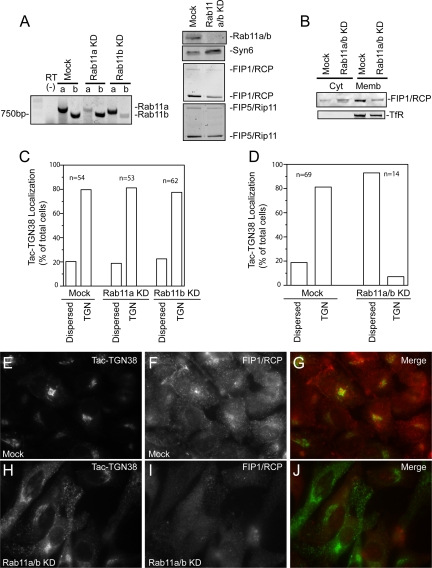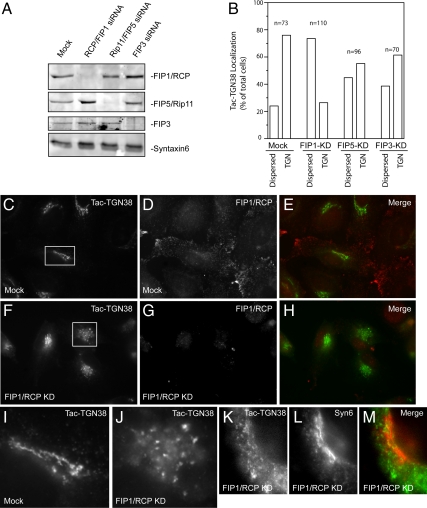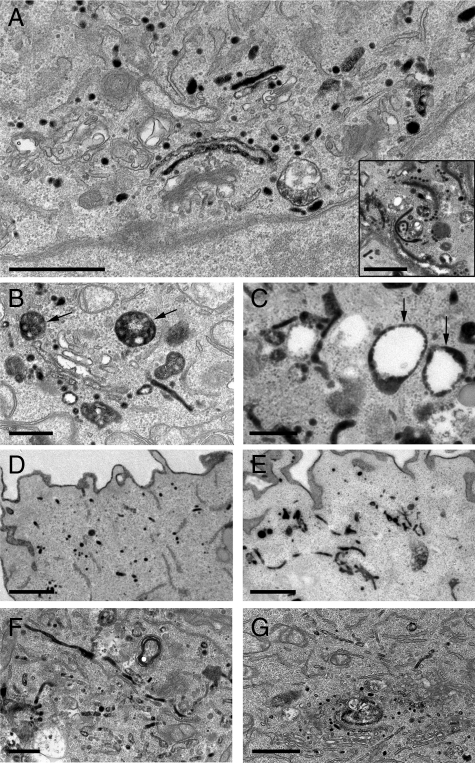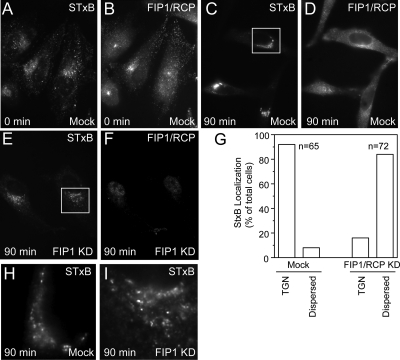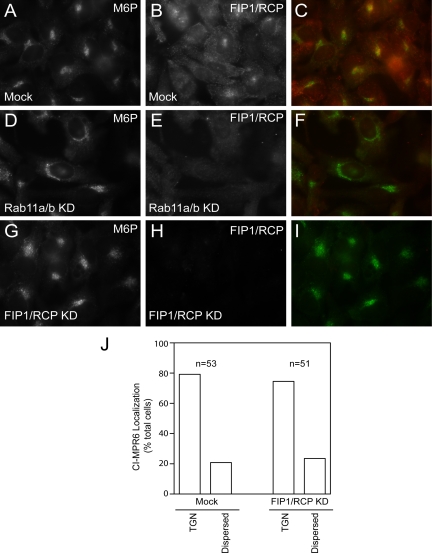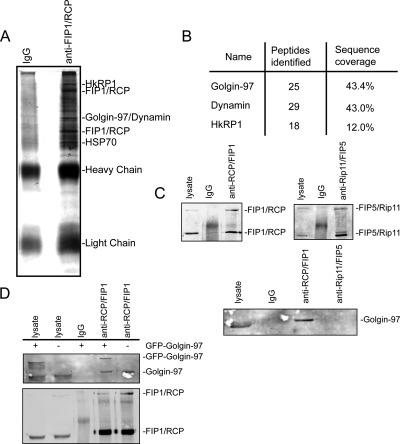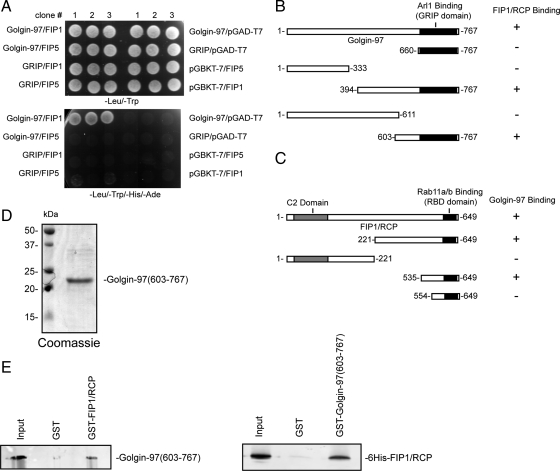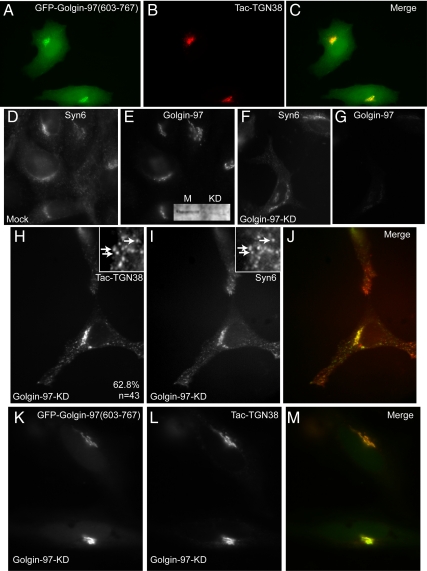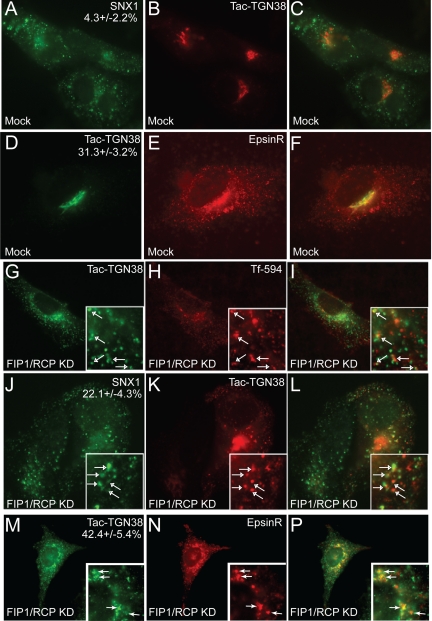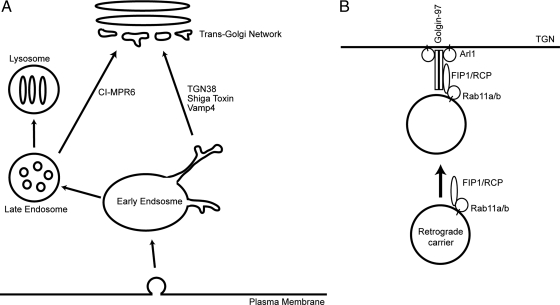This study shows that Rab11 and its binding protein FIP1 are required for retrograde delivery of TGN38 and Shiga toxin from early/recycling endosomes to the TGN. We also demonstrate that Golgin-97 as a FIP1-binding protein and that this binding regulates the targeting of retrograde transport vesicles to the TGN.
Abstract
Many proteins are retrieved to the trans-Golgi Network (TGN) from the endosomal system through several retrograde transport pathways to maintain the composition and function of the TGN. However, the molecular mechanisms involved in these distinct retrograde pathways remain to be fully understood. Here we have used fluorescence and electron microscopy as well as various functional transport assays to show that Rab11a/b and its binding protein FIP1/RCP are both required for the retrograde delivery of TGN38 and Shiga toxin from early/recycling endosomes to the TGN, but not for the retrieval of mannose-6-phosphate receptor from late endosomes. Furthermore, by proteomic analysis we identified Golgin-97 as a FIP1/RCP-binding protein. The FIP1/RCP-binding domain maps to the C-terminus of Golgin-97, adjacent to its GRIP domain. Binding of FIP1/RCP to Golgin-97 does not affect Golgin-97 recruitment to the TGN, but appears to regulate the targeting of retrograde transport vesicles to the TGN. Thus, we propose that FIP1/RCP binding to Golgin-97 is required for tethering and fusion of recycling endosome-derived retrograde transport vesicles to the TGN.
INTRODUCTION
In eukaryotic cells, newly synthesized proteins at the trans-Golgi network (TGN) are sorted to different destinations. To maintain the composition and function of the TGN, selected proteins are retrieved back to the TGN from the endosomal system through several distinct retrograde transport pathways (Bonifacino and Rojas, 2006). During the process of early endosome maturation into late endosomes, some cargo proteins exit endosomes and traffic via a retrograde pathway back to the TGN. The number and specificity of these pathways still remain controversial, for example, with the respect to the exit sites of cargo proteins from different types of endosomes (early, late or recycling endosomes). Recent work suggests that there are at least two main retrograde pathways from endosomes to the TGN (Rohn et al., 2000). Furin (Mallet and Maxfield, 1999) and the mannose 6-phosphate receptors (MPRs) are transported from early/late endosomes (EE/LE retrograde pathway) to the TGN (Barbero et al., 2002). In contrast, some other retrograde cargo proteins, such as TGN38/46 (Ghosh et al., 1998), various extracellular toxins (Mallard et al., 1998), and VAMP4 (Tran et al., 2007), are trafficked from early and/or recycling endosomes back to the TGN (EE/RE retrograde pathway).
Recently, several protein families have emerged as important regulators of the targeting and specificity at the different stages of various retrograde transport pathways. For example, the retromer complex mediates the initial stage of cargo sorting and retrograde carrier formation. The retromer complex was identified in yeast as Vps5p-Vps17p and Vps26p-Vps29p-Vps35p complex, whose mammalian orthologue is a hetero-pentameric complex comprised of a sorting nexins 1/2 (SNX1/2) dimer and a Vps26-Vps29-Vps35 hetero-trimer. The main function of SNX1/2 is to drive the formation of tubular retrograde transport carriers and recruit the Vps26-Vps29-Vps35 hetero-trimer to endosomes. The Vps26-Vps29-Vps35 hetero-trimer is proposed to recognize various cargo proteins, thus regulating retrograde sorting (Seaman et al., 1997; Seaman, 2005; Bonifacino and Hurley, 2008). Indeed, the retromer complex was shown to regulate retrograde transport of various cargo molecules, such as MPRs (Arighi et al., 2004; Carlton et al., 2004; Rojas et al., 2007), Shiga toxin (Bujny et al., 2007; Utskarpen et al., 2007), Wntless (Coudreuse et al., 2006; Belenkaya et al., 2008; Franch-Marro et al., 2008; Port et al., 2008) and SNAREs (Hettema et al., 2003). Interestingly, these proteins are thought to traffic through different retrograde transport pathways, suggesting that the retromer complex may play a general role at an early stage of most retrograde transport pathways.
In contrast to the retromer complex, SNAREs and various tethering factors mediate late-stage docking and fusion of retrograde carriers with the TGN, likely from distinct donor organelles. The best studied family of coiled-coil tethering proteins is the TGN-localized Golgins, which are characterized by conserved C-terminal GRIP domain, preceded by an extensive coiled-coil domain (Munro and Nichols, 1999; Gillingham and Munro, 2003). The Golgin family of proteins consists of four members, namely Golgin-97, Golgin-245, GCC88, and GCC185, which appear to regulate distinct retrograde transport pathways the TGN. For example, GCC185 tethers Rab9-positive vesicles originating from the EE/LE (Burguete et al., 2008; Ganley et al., 2008), whereas Golgin-97 and GCC88 have been proposed to tether early EE/RE-derived vesicles (Lu et al., 2004; Lieu et al., 2007).
Several Rab GTPases have recently emerged as key regulators of the retrograde transport from endosomes to the TGN. At least five different Rabs were shown to regulate retrograde transport from late endosomes to TGN. Rab5 and Rab7 were shown to regulate the recruitment of the retromer complex to endosomes (Rojas et al., 2008). Rab9, and its putative effector Tip47, were suggested to mediate cargo selection into EE/LE-derived carriers (Diaz et al., 1997; Diaz and Pfeffer, 1998), although this remains controversial (Bulankina et al., 2009). Finally, Rab6 binding to GCC185 promotes the tethering of Rab9-positive, EE/LE-derived retrograde carriers to the TGN (Burguete et al., 2008). In addition, Rab11 also regulates retrogrades transport from recycling endosomes to the TGN (Wilcke et al., 2000). Rab11 binds to a family of proteins, known as the Rab11 family interacting proteins (FIPs; Prekeris et al., 2000; Hales et al., 2001; Lindsay et al., 2002; Meyers and Prekeris, 2002). FIPs form mutually exclusive complexes with Rab11/25 and serve as “target complexes” in regulating specific endocytic transport pathways (Meyers and Prekeris, 2002). We have proposed that FIPs serve as a scaffolding platform for the recruitment of other effectors to this “target complex.”
Although the roles of Rab11 GTPases and their interacting proteins in regulating endocytic recycling are becoming elucidated, their role in mediating retrograde transport from endosomes to the TGN remains unclear. Here we show that knockdown of Rab11a/b or its interacting protein FIP1/RCP, but not FIP3 or FIP5/Rip11, inhibits TGN transport of TGN38, Shiga toxin B (STxB), and VAMP4, while having no effect on retrograde traffic of MPRs. We further demonstrate that FIP1/RCP directly binds to Golgin-97 in vitro and in vivo and that this interaction is required for the retrograde transport from EE/RE to the TGN. Thus, we propose that FIP1/RCP binding to Golgin-97 is required for TGN tethering and subsequent fusion of recycling endosome-derived, Rab11-positive, retrograde carriers.
MATERIALS AND METHODS
Cell Culture and Imaging
HeLa cells were cultured in DMEM supplemented with 10% (vol/vol) heat-inactivated fetal bovine serum and 2 mM l-glutamine. Stable HeLa cells expressing CD8-CI-MPR6 was the generous gift from Dr. Seaman's laboratory and were described previously (Seaman, 2004). Where indicated, HeLa cells were transfected using an electroporation procedure as described in the manufacturer's protocol (Bio-Rad, Hercules, CA).
For imaging HeLa cells were plated on collagen-coated glass coverslips, grown overnight, and fixed with 4% paraformaldehyde, followed by quenching with 0.1 M glycine. Cells were then permeabilized with phosphate-buffered saline containing 0.4% saponin, 2% fetal bovine serum, and 1% bovine serum albumin for 30 min, followed by incubation with primary antibodies. After extensive washing, cells were incubated with Texas Red or FITC-conjugated secondary antibodies (Jackson ImmunoResearch Laboratories; West Grove, PA) for 30 min, washed, and mounted with Vectashield (Vector Laboratories, Burlingame, CA). Cells were imaged with a Zeiss Axiovert 200M deconvolution microscope (Thornwood, NY). Images were processed using Intelligent Imaging Innovations (Denver, CO) three-dimentional rendering and exploration software.
Antibodies
Rabbit polyclonal anti-Rab11a/b (pan-Rab11), anti-FIP1/RCP, anti-Rip11/FIP5, anti-FIP3, and anti-VAMP4 antibodies were described previously (Prekeris et al., 2000; Peden et al., 2004; Wilson et al., 2005). Please note that anti-FIP1/RCP and anti-FIP5/Rip11 antibodies detect both ∼70- and ∼150-kDa splice isoforms of these proteins, although in some gels, because space limitations, we shown only predominant ∼70-kDa isoform. Mouse monoclonal anti-Golgin-97 antibody was purchased from Molecular Probes/Invitrogen (Eugene, OR). The anti-Tac hybridoma cell line 7G7 and tac-TGN38 expression construct were generous gifts from Dr. Mickey Marks (University of Pennsylvania). The 7G7 antibody was affinity-purified from hybridoma supernatant using anti-mouse IgG (Jackson ImmunoResearch Laboratories, West Grove, PA). Mouse monoclonal anti-myc (9E10) antibody and goat anti-SNX1 antibody were purchased from Santa Cruz Biotechnology (Santa Cruz, CA). Mouse monoclonal anti-Tac antibody was purchased from Invitrogen (Carlsbad, CA). Mouse monoclonal anti-CD8 antibody was obtained from BD PharMingen (San Jose, CA). Anti-Vps26 and anti-Vps29 antibodies were generous gift from Dr. Juan Bonifacino (National Institutes of Health). Texas Red and FITC-conjugated secondary antibodies were obtained from Jackson ImmunoResearch Laboratories. Alexa594-labeled transferrin was obtained from Molecular Probes/Invitrogen (Carlsbad, CA).
Electron Microscopy
For electron microscopy, HeLa cells were transiently transfected with FIP1/RCP small interfering RNA (siRNA). After 48 h, cells were then transfected with TGN38-horseradish peroxidase (HRP) and incubated for additional 24 h. TGN38-HRP construct was previously described (Metcalf et al., 2008). TGN38- HRP-containing compartments were then preserved by performing the DAB reaction before digitonin permeabilization and PFA fixation essentially as described previously (Futter et al., 1998). Thin sections, 60–70-nm thick, were cut using a Reichert-Jung Ultracut E microtome (Depuy, NY), stained with lead citrate and viewed in a Phillips CM12 transmission electron microscope (Mahwah, NJ). Some additional images were captured using a Morada CCD camera (Olympus Soft Imaging Systems, Melville, NY) coupled to a Tecnai G2 Spirit transmission electron microscope (FEI, Eindhoven, The Netherlands), running iTEM software.
RNA Interference Analysis
siRNA duplexes for FIP1/RCP (RCPb 5′-CGCCTCTTTCCCAGTCCATGT-3′, RCPc 5′-GGCCTGCTGAAGACCTTGTGT-3′, RCPd 5′-AGCCCCTCGGACCCTGCATTT-3′), FIP3 (5′-AAGGGATCACAGCCATCAGAA-3′), Rip11/FIP5 (5′-AAGAGCTGAGTGCTCAGGCTA-3′), Rab11a (5′-AATGTCAGACAGACGCGAAAA-3′), and Rab11b (5′-AAGCACCTGACCTATGAGAAC-3′) were based on human sequences and were described previously (Peden et al., 2004; Junutula et al., 2004; Wilson et al., 2005; Schoneteich et al., 2008). siRNA duplexes for Golgin-97 were previously described (Lu et al., 2004; Lieu et al., 2007). For knockdown experiments cells were transfected with 10 nM HPP grade siRNA (QIAGEN, Valencia, CA) using Lipofectamine 2000 (Invitrogen, Carlsbad, CA) based on manufacturer's protocol. Transfected cells were incubated for 72 h and analyzed using immunofluorescence microscopy or immunoblotting.
Reverse Transcriptase Polymerase Chain Reaction
HeLa cells were either mock-transfected or transfected with Rab11a or Rab11b siRNA. Total RNA was then extracted from 2 × 107 cells using TRIzol (Invitrogen) according to manufacturers protocol. Reverse transcription to cDNA was performed with SuperScript III (Invitrogen) using random hexamers. PCR was performed using Taq polymerase (Invitrogen). All reactions were performed for 40 cycles with the following parameters: 94°C, 60 s; 55°C, 60 s; and 72°C, 90 s. Primers for amplification of Rab11a and Rab11b were previously reported and are expected to generate 759bp (Rab11a) or 586bp (Rab11b) PCR fragment (Cheng et al., 2006).
Immunoprecipitation and Proteomics
HeLa cell lysates from 20 10-cm plates were harvested in the presence of 1% Triton X-100. Cell lysates were then incubated overnight with either 20 μg/ml lysate of affinity-purified rabbit anti-FIP1/RCP antibodies or 20 μg/ml lysate of purified nonspecific rabbit IgG, followed by addition of 100 μl of protein A-Sepharose per 1 ml of lysate. Beads were then washed, eluted with 1% SDS, and separated on a 7–14% gradient acrylamide gel. The resulting gel was Coomassie-stained, and bands present only in the anti-FIP1/RCP immunoprecipitate were isolated. Gel bands were cut in three equal sections and in-gel digested using three proteases. Peptides were extracted from the gel pieces with 0.1% TFA/60% acetonitrile and lyophilized. Dried peptide samples from each gel band were rehydrated and loaded onto a microcapillary column (100-μm-inner-diameter fused silica) packed with 15 cm Aqua C18 reverse-phase material and then placed in-line with an LTQ linear trap mass spectrometer. Peptides were eluted with 2-h mobile gradient of acetonitrile/0.1% formic acid. Tandem mass spectra were analyzed using Sequest using a human–mouse–rat database concatenated to a randomized human–mouse–rat database. DTASelect was used to reassemble identified peptides into proteins. Identified proteins were filtered at <5% FDR.
Yeast Two-Hybrid Assay
A series of bait constructs (in pGBKT7 vector) were constructed using the following cDNAs: FIP1/RCP, FIP1/RCP(aa1-221), FIP1/RCP(aa221-649), FIP1/RCP(aa535-649), FIP1/RCP(aa554-649), and Rip11/FIP5. For prey constructs, the following cDNAs were inserted into pGAD vector: Golgin-97, Golgin-97(aa660-767), Golgin-97(aa1-333), Golgin-97(aa394-767), Golgin-97(aa1-611), and Golgin-97(aa603-767). A series of constitutively active GTP-bound Rab GTPases were cloned into bait pGBKT7 vector and FIP1/RCP into prey pGAD vector. The interaction between bait and prey was measured using DDO and QDO growth assay according to manufacturer's protocol (Clontech, Palo Alto, CA).
Anti-Tac Antibodies and STxB Uptake Assays
To generate Tac-TGN38 expressing HeLa cell line, Tac-TGN38 was cloned into retroviral expression vector pLXIN (Clontech, Palo Alto, CA). A population of HeLa cells, expressing the reporter construct, was generated by viral transduction.
For anti-Tac antibody uptake assays, mock- or FIP1/RCP siRNA-treated stable HeLa cells expressing Tac-TGN38 were seeded on collagen-coated coverslips in the presence of HEPES-buffered (final 20 mM HEPES) serum-supplemented DMEM media. Cells were first and incubated with 10 μg/ml anti-Tac antibodies for 1 h at 4°C to bind anti-tac antibody to plasma membrane–associated tac-TGN38. Cells were then washed twice and incubated at 37°C for 3 h to allow anti-Tac antibody uptake and delivery to TGN. Cells were then fixed and stained with anti-Tac and anti-RCP antibodies. The tac-TGN38 localization to TGN or dispersed phenotypes were quantitated by microscopy by counting at least 30 randomly chosen cells.
The Shiga toxin light chain was cloned into bacterial expression vector pET22B (Novagen, Madison, WI), which introduced a signal peptide at the toxins N-terminus, and 6His at its C-terminus. The toxin-encoding plasmid was transformed into BL21 cells and protein-purified as previously described. Internalized Shiga toxin was detected using mouse anti-6His mAb (Roche, Penzberg, Germany).
For STxB uptake assays, mock- or FIP1/RCP siRNA-treated HeLa cells were incubated with purified recombinant 6His-STxB at 18°C for 60 min to allow internalization and accumulation of 6His-STxB in early endosomes. Retrograde transport from early endosomes to TGN was then initiated by incubating cells at 37°C for 90 min. Cells were then fixed and stained with anti-FIP1/RCP and anti-6His antibodies. STxB TGN localization or dispersed phenotype was quantitated by microscopy by counting at least 30 randomly chosen cells.
RESULTS
Rab11 Is Required for the Localization of TGN38 to TGN
Although Rab6 and Rab9 have been implicated in retrograde transport from EE/LE to the TGN (Diaz and Pfeffer, 1998; Del Nery et al., 2006; Burguete et al., 2008), the Rabs involved in EE/RE-to-TGN transport are not well characterized. Although overexpression of various Rab11 mutants inhibits the retrograde transport of Shiga toxin and TGN38 to the TGN (Wilcke et al., 2000), the specificity of these Rab11 mutants is controversial, and the precise isoform (Rab11a or Rab11b) that regulates retrograde transport is unclear. We therefore examined the roles of Rab11a and Rab11b GTPases in retrograde transport of various cargo molecules. We first investigated the localization of TGN38, a protein that cycles between the plasma membrane, endosomes, and the TGN. To that end, Tac-TGN38 stably expressing HeLa cells (HeLa-Tac-TGN38) were transfected with siRNA to Rab11a, Rab11b, or both (Figure 1A). As previously reported, in mock-treated cells Tac-TGN38 was predominately localized to the TGN (Figure 1, C and D, and E–G). The knockdown of Rab11a or Rab11b alone had no effect on Tac-TGN38 localization (Figure 1C), whereas knockdown of both isoforms resulted in dispersal of TGN38 (Figure 1, D, H, and I). We have showed that Rab11a and Rab11b are required for endosomal recruitment of FIPs (Junutula et al., 2004; Wilson et al., 2005). Indeed, Rab11a/b double knockdown causes the redistribution of FIP1/RCP from endocytic membranes to the cytosol, as assessed by membrane fractionation and Western blotting (Figure 1B), resulting in significantly decreased punctuate FIP1/RCP staining (Figure 1I). Interestingly, Rab11a/b knockdown also resulted in a slight decrease in FIP1/RCP (to 71.2% of mock) and FIP5/Rip11 (to 92.6% of mock) levels, suggesting that, once redistributed to cytosol, these Rab11 effector proteins may be a subject to increased degradation. Once again, this was not observed in the knockdowns of single Rab11 isoforms (data not shown). Thus, our data suggest that both Rab11 isoforms are redundantly involved in retrograde transport of TGN38 from EE/RE to the TGN.
Figure 1.
Rab11 is required for TGN38 retrograde transport to TGN. (A, left) RT-PCR analysis to determine the efficiencies of Rab11a and Rab11b knockdown. (A, right) Lysates from mock- or Rab11a/b siRNA-treated cells were immunoblotted with pan-Rab11, anti-Syntaxin 6, anti-FIP1/RCP, and anti-FIP5/Rip11 antibodies. (B) Mock- or Rab11a/b siRNA-treated cells were fractionated into cytosol and membrane fractions and immunoblotted for Rab11-binding protein FIP1/RCP and transferring receptor. Please note that in these immunoblots we show only the predominant ∼70-kDa splice isoform of FIP1/RCP. (C and D) Mock-, Rab11a, Rab11b, or Rab11a/b siRNA-treated cells HeLa-Tac-TGN38 cells were analyzed. Cells were scored for TGN38 localization and divided in dispersed or TGN-localized categories. n is the number of cells analyzed. (E–J) Mock- (D–G) or Rab11a/b siRNA-treated (H–J) HeLa-Tac-TGN38 cells were fixed and costained with anti-FIP1/RCP (red channel, F and I) and anti-Tac (green channel, E and H) antibodies.
The Rab11 Effector Protein, FIP1/RCP, Is Required for Retrograde TGN38 Transport
Rab11 GTPases work by recruiting effector proteins to recycling endosomes, but utilize different FIP proteins for their different functions (for review see Jing and Prekeris, 2009). Furthermore, our data already have shown that Rab11a/b knockdown leads to the decreased cellular levels of some of the FIPs. We therefore decided to test the role of different FIPs in retrograde transport of TGN38 by using FIP-specific siRNAs (Peden et al., 2004; Wilson et al., 2005; Schonteich et al., 2008) to knockdown FIP5/Rip11, FIP1/RCP, and FIP3 in HeLa -Tac-TGN38 cells (Figure 2A). Depletion of FIP1/RCP resulted in redistribution of Tac-TGN38 from TGN to perinuclear punctuate organelles (Figure 2, B–J), whereas knockdown of FIP3 or FIP5/Rip11 had little effect on Tac-TGN38 distribution (Figure 2B). To confirm that these perinuclear punctuate organelles do not represent TGN, we costained FIP1/RCP siRNA-treated cells with anti-Tac and anti-Syntaxin 6 (the protein known to reside in the TGN) antibodies. Consistent with the involvement of FIP1/RCP in Tac-TGN38 transport to the TGN, there is little colocalization between Tac-TGN38 and Syntaxin 6 in cells depleted of FIP1/RCP (Figure 2, K–M). In contrast, in mock-treated cells, Tac-TGN38, and Syntaxin 6 almost completely overlapped (data not shown). These results were further confirmed with two additional FIP1/RCP siRNAs (siRNAc and siRNAd), which also resulted in redistribution of Tac-TGN38 from the TGN to perinuclear punctuate organelles (Supplemental Figure 1).
Figure 2.
FIP1/RCP knockdown affects the retrograde transport of TGN38. (A) Stable HeLa-Tac-TGN38 cells were either mock-transfected or transfected with FIP1/RCP, FIP5/Rip11, or FIP3 siRNAs. Cells were then harvested and the total levels of FIP1/RCP, FIP5/Rip11, FIP3, and Syntaxin 6 were determined by immunoblotting. Please note that although siRNAs caused the knockdown of both splice isoforms, in these immunoblots we only show the predominant ∼70-kDa splice isoforms of FIP1/RCP and FIP5/Rip11. (B) Tac-TGN38 localization was analyzed in mock-, FIP1/RCP, FIP5/Rip11, or FIP3 siRNA-treated cells. Cells were scored for TGN38 localization and divided as dispersed or TGN-localized categories. n is the number of cells analyzed. (C–J) Mock- (C–E and I) or FIP1/RCP siRNA-treated (F–H and J) HeLa-Tac-TGN38 cells were fixed and stained with anti-FIP1/RCP (D and G) and anti-Tac (C, F, I, and J) antibodies. I and J are higher-magnification images of the boxed regions from C and F. (K–M) FIP1/RCP siRNA-treated HeLa-Tac-TGN38 cells were fixed and stained with anti-Syntaxin 6 (L and M) and anti-Tac (K and M) antibodies.
To further confirm that FIP1/RCP mediates TGN38 cycling between endosomal organelles and the plasma membrane, we incubated HeLa-Tac-TGN38 cells in the presence of anti-Tac antibody and monitored antibody uptake into HeLa cells. As previously reported, in the majority of mock-treated cells (63.6%, n = 44; and data not shown) anti-Tac antibody is delivered to the TGN. By contrast, depletion of FIP1/RCP blocked the ability of the anti-Tac antibody to be delivered to the TGN and resulted in its accumulation in peripheral organelles (scattered distribution in 88% cells; n = 36; and data not shown), most likely endosomes. To further confirm the effect of FIP1/RCP knockdown on TGN distribution, we transfected mock- or FIP1/RCP siRNA-treated cells with TGN38-HRP and analyzed its distribution by electron microscopy. In mock cells, as expected, TGN38-HRP was found in the TGN, early endosomes, and recycling vesicles and tubules (Figure 3, A, inset, C, and E, respectively). However in cells treated with FIP1/RCP siRNAs, there appeared to be less TGN38-HRP localized to the TGN, when compared with mock-treated cells (Figure 3A). Furthermore, some TGN38-HRP was found to mislocalize to multivesicular bodies, presumably en route for degradation (Figure 3, B and D).
Figure 3.
FIP1/RCP is required for the transport of TGN38 from endosomes to TGN. (A–E) HeLa cells treated with either mock siRNA or FIP1/RCP siRNA were transfected with HRP-TGN38. (A) FIP1/RCP siRNA-treated cells with panel showing mock-treated cells; scale bars, 1 μm. (B and D) FIP1/RCP siRNA-treated cells in the perinuclear region and periphery, respectively; scale bars, (B) 500 nm, (D) 1 μm. (C and E) Mock siRNA-treated cells in the perinuclear region and periphery, respectively; scale bars, (C) 500 nm, (E) 1 μm. (F and) G) HeLa cells transfected with TGN38-HRP and GFP-RBD; scale bars, (F) 500 nm, (G) 1 μm.
To further test whether Rab11 and FIP1/RCP are required for retrograde transport of TGN38, we transfected HeLa cells with green fluorescent protein (GFP)-tagged Rab11-binding domain (GFP-RBD), which was previously shown to act as a dominant-negative inhibitor of all FIPs by competing for binding to Rab11 (Junutula et al., 2004). As shown in Figure 3, F and G, overexpression of GFP-RBD resulted in the redistribution of TGN38-HRP to elongated tubular elements of the recycling endosome, with very little TGN38-HRP observed in TGN.
The change in Tac-TGN38 localization could be the result of either inhibition of its transport from endosomes to TGN or of Golgi fragmentation. To exclude the latter possibility, we analyzed the localization the TGN marker Golgin-97. As shown in Supplemental Figure 2, there was no effect of either Rab11a/b or FIP1/RCP knockdown on localization of Golgin-97, suggesting that Rab11a/b or FIP1/RCP depletion did not result in Golgi fragmentation.
Although FIP1/RCP has been described as a Rab11a/b interacting protein (Lindsay et al., 2002; Peden et al., 2004), its ability to interact with other Rab GTPases has not been extensively studied. Therefore, we cannot fully rule out the possibility that in addition to Rab11a/b, FIP1/RCP may bind to other Rab GTPases involved in the retrograde pathway, for instance Rab5, Rab6, Rab7, and Rab9 (Diaz et al., 1997; Diaz and Pfeffer, 1998; Burguete et al., 2008; Rojas et al., 2008). Furthermore, a recent report suggested that FIP1/RCP may bind Rab14 in vitro (Kelly et al., 2009). We therefore tested the ability of FIP1/RCP to bind to all other Rab GTPases using yeast two-hybrid assays. We found that only Rab11a/b and to a lesser extent Rab25 interacted with FIP1/RCP (Supplemental Figure 3A). Notably, we did not detect any interactions between Rab14 and FIP1/RCP, perhaps because in our yeast two-hybrid assay we used −His,−Leu,−Trp,−Ade selection, which favors only high-affinity interactions. To further test whether Rab14 binds to FIP1/RCP, we used glutathione bead–binding assays. As shown in Supplemental Figure 3B, we could not detect any interaction between Rab14 and FIP1/RCP or FIP5/Rip11, at least at affinities comparable to GTP-dependent Rab11 binding (50–100 nM). These data indicate that effects of FIP1/RCP on retrograde transport are indeed likely mediated by Rab11a/b, and not other Rab GTPases.
FIP1/RCP Mediates Retrograde Transport via EE/RE-to-TGN But Not EE/LE-to-TGN Pathway
Like TGN38, STxB and VAMP4, also traffic to the TGN via EE/RE (Rohn et al., 2000; Popoff et al., 2007; Tran et al., 2007) and thus also may require Rab11a/b and FIP1/RCP. Therefore, we have performed an STxB uptake assay to further confirm the role of Rab11a/b and FIP1/RCP in the EE/RE-to-TGN trafficking pathway. Toward this objective, we incubated HeLa cells at 18°C in the presence of STxB. It has been shown that STxB binds to the plasma membrane from where it is endocytosed to EE, where it is sorted away from the degradative pathway to RE, before being transferred to the TGN (Mallard et al., 1998; Sandvig and van Deurs, 2005). Incubation of HeLa cells at 18°C accumulates STxB in EE (Figure 4, A and B). Retrograde transport of STxB from EE to the TGN can then initiated by shifting cells to 37°C. As shown in Figure 4, C, D, G, and H, most of STxB is transported to the TGN after 90-min incubation at 37°C. The knockdown of FIP1/RCP accumulated StxB in perinuclear punctuate organelles (Figure 4, E–G and I), indicating that FIP1/RCP may indeed be a general regulator of cargo transport from EE/RE to the TGN. This was further confirmed by the redistribution of VAMP4 from the TGN to peripheral punctuate organelles upon FIP1/RCP knockdown (Supplemental Figure 4).
Figure 4.
Retrograde transport of STxB is impaired in FIP1/RCP-depleted cells. (A and B) HeLa cells were incubated with 6His-STxB at 18°C for 60 min to accumulate in EE. Cells were then washed, fixed, and stained with anti-FIP1/RCP (B) and anti-6His (A) antibodies. (C–F and H–I) Mock- (C, D, and H) or FIP1/RCP (E, F, and I) siRNA-treated HeLa cells were incubated with 6His-STxB at 18°C for 60 min. Cells were then washed, and retrograde transport of 6His-STxB from EE to TGN was initiated by incubating cells at 37°C for 90 min. Cells were then fixed and stained with anti-FIP1/RCP (D and F) and anti-6His (C, E, H, and I) antibodies. H and I are higher-magnification images from the boxed regions in C and E. (G) Quantitation of 6His-STxB localization (TGN or dispersed) in mock- or FIP1/RCP siRNA-treated cells, after loading cells with 6His-STxB at 18°C, followed by 90-min incubation at 37°C as in C–I. n is the number of cells analyzed.
In contrast to STxB, VAMP4 and TGN38, MPRs take the EE/LE route to the TGN (Diaz and Pfeffer, 1998; Barbero et al., 2002) and require Rab9 GTPase and its possibly effector protein TIP47. To test whether Rab11a/b and FIP1/RCP may also regulate the EE/LE-to-TGN pathway, we analyzed the distribution of endogenous CI-MPR in mock-, Rab11a/b, or FIP1/RCP siRNA-treated cells. CI-MPR was enriched at the TGN, as expected, in majority of the mock cells (Figure 5, A–C; Supplemental Figure 5, A–C), and Rab11a/b or FIP1-RCP knockdown had no effect on its distribution (Figure 5, D–I, Supplemental Figure 5, D–F). These results were confirmed using CD8-tagged CI-MPR–expressing HeLa cells. Similarly to endogenous CI-MPR, CD8-tagged CI-MPR was enriched in the TGN region in the majority of cells (79.6%; n = 53; Figure 5J) and was not affected by FIP1/RCP knockdown (Figure 5J), suggesting that Rab11a/b and FIP1/RCP are not involved in the retrograde transport from EE/LE.
Figure 5.
FIP1/RCP is not required for CI-MPR6 retrograde transport. (A–I) Mock- (A–C), Rab11a/b (D–F), or FIP1/RCP (G–I) siRNA-treated HeLa cells, stably expressing CD8-CI-MPR6, were fixed and stained with anti-FIP1/RCP (B, E, and H, red channel) and anti-CD8 (A, D, and G, green channel) antibodies. (J) Quantitation of CD8-CI-MPR6 localization (TGN or dispersed) in mock- or FIP1/RCP siRNA-treated HeLa cells. n is the number of cells analyzed.
Golgin-97 Is a FIP1/RCP-Binding Protein
Rab11/FIP complexes were demonstrated to act as scaffolding complexes that mediate the binding of other membrane transport proteins (for review see Jing and Prekeris, 2009). FIP1/RCP has been shown to mediate recycling from endosomes to the plasma membrane (Damiani et al., 2004; Peden et al., 2004; Caswell et al., 2008), as well as EE/RE to the TGN (above). To identify the proteins that interact with FIP1/RCP-Rab11 scaffolding complex, we immunoprecipitated FIP1/RCP from HeLa cell lysates using anti-FIP1/RCP antibodies and analyzed the specific immunoisolated protein bands by mass spectrometry (Figure 6, A and B). Among the reproducibly FIP1/RCP-complexed proteins were Hsp70, Golgin-97, dynamin, and Hook related protein1 (HkRP1). Because, Golgin-97 is known to be recruited to the TGN through an interaction with Arl1-GTP (Lu et al., 2006) and already has been proposed to function as a tethering factor in endosome-to-TGN retrograde traffic (Lu et al., 2004), we focused further on this interaction.
Figure 6.
Golgin-97 is a FIP1/RCP-binding protein. (A and B) FIP1/RCP was immunoprecipitated from HeLa cell lysate with anti-FIP1/RCP antibodies. The candidate bands in the anti-FIP1/RCP but not the nonspecific IgG lane were cut from the gel and analyzed by MS/MS-LCQ. The immunoprecipitation and subsequent proteomic analysis was done three times. Only proteins identified all three times are listed in the figure. (C) FIP1/RCP or FIP5/Rip11 were immunoprecipitated from HeLa cell lysate with anti-FIP1/RCP or anti-FIP5/Rip11 antibodies and analyzed for the presence of Golgin-97 by Western blotting with anti-Golgin-97 antibody. (D) FIP1/RCP was immunoprecipitated from HeLa cells transfected with GFP-Golgin-97. Precipitate was then analyzed for the presence of FIP1/RCP, Golgin-97, and GFP-Golgin-97.
We first examined the specificity of FIP1/RCP and Golgin-97 interaction by performing immunoprecipitation experiments with anti-FIP1/RCP or anti-FIP5/Rip11 antibodies. Consistent with our mass spectrometry data, Golgin-97 binds specifically to FIP1/RCP, as it coprecipitated only with FIP1/RCP, but not with FIP5/Rip11 (Figure 6, C and D). To further confirm FIP1/RCP binding to Golgin-97, we have conducted immunoprecipitation experiments using anti-FIP1/RCP antibodies from HeLa cells expressing GFP-Golgin-97. As shown in Figure 6D, GFP-Golgin-97 also coimmunoprecipitated with FIP1/RCP antibodies.
To determine whether FIP1/RCP directly binds to Golgin-97, we tested the interaction using yeast two-hybrid system. Indeed, FIP1/RCP, but not FIP5/Rip11, interacted directly with Golgin-97 (Figure 7A). By contrast, Golgin-97 did not bind directly to Rab11a (data not shown). Furthermore, Golgin-97 truncation analyses revealed that FIP1/RCP binds to Golgin-97 via a region distinct from the GRIP domain (Figure 7B), which mediates Arl1-dependent recruitment of Golgin-97 to the TGN (Lu and Hong, 2003; Panic et al., 2003). These binding data are consistent with the lack of the effect of FIP1/RCP on targeting Golgin-97 to the TGN (Supplemental Figure 2). To further test whether Golgin-97(aa603-767) is sufficient to mediate Golgin-97 binding to FIP1/RCP, we incubated glutathione beads bound to either glutathione S-transferase (GST) alone or GST-FIP1/RCP with recombinant 6His-Golgin-97(aa603-767). As shown in the Figure 7, D and E, 6His-Golgin-97(aa603-767) directly interacted with GST- FIP1/RCP. To further confirm that Golgin-97(aa603-767) directly binds to FIP1/RCP, we also incubated beads bound to GST-Golgin-97(aa603-767) with recombinant 6His-FIP1/RCP. Once again, 6His-FIP1/RCP bound to GST-Golgin-97(aa603-767) but not GSTR alone (Figure 7E).
Figure 7.
Mapping the binding between Golgin-97 and FIP1/RCP. (A) The interactions between different truncation mutants of Golgin-97, FIP1/RCP, and FIP5/Rip11 were analyzed using the yeast two-hybrid assay. Growth of three separate yeast clones in −Leu/−Trp and −Leu/−Trp/−His/−Ade plates were analyzed for each binding combination. (B and C) Truncation analyses of binding between Golgin-97 and FIP1/RCP were carried out using the yeast two-hybrid assay. Three different yeast clones were analyzed for each binding combination and the results summarized as binding (+) or not (−). (D and E) To confirm the yeast two-hybrid assays, 6His-Golgin-97(aa603-767) or GST-Golgin-97(aa603-767) was expressed using the baculovirus system and purified using Ni2+ chromatography (see Coomassie gel in the bottom panel). (E, left) Purified recombinant 6His-Golgin-97(aa603-767) was incubated with glutathione beads coated with either GST alone or GST-FIP1/RCP. Beads were then washed and presence of 6His-Golgin-97(aa603-767) tested by immunoblotting with anti-His6. (E, right) Recombinant 6His-FIP1/RCP was incubated with glutathione beads coated with either GST alone or GST-Golgin-97(aa603-767). Beads were then washed and presence of 6His-FIP1/RCP tested by immunoblotting with anti-FIP1/RCP antibody.
FIP1/RCP truncation analysis was also performed to identify the Golgin-97–binding motif. Residues 535-554 of FIP1/RCP were required for Golgin-97 binding (Figure 7C), and this is distinct from the Rab11-interaction motif that is shown to be localized at the very C-terminus of FIPs (Prekeris et al., 2000; Eathiraj et al., 2006; Jagoe et al., 2006).
The Golgin-97-GRIP domain is sufficient for the recruitment of Golgin-97 to TGN (Lu and Hong, 2003; Panic et al., 2003) and furthermore can act as a dominant negative mutant blocking STxB and TGN38 transport to the TGN, presumably by competing with endogenous Golgin-97 for binding to Arl1 (Lu et al., 2004). GFP-Golgin-97(aa603-767) could also be targeted to the TGN (Figure 8A), albeit less efficiently than full-length GFP-Golgin-97 (data not shown). Interestingly, unlike the GRIP domain, GFP-Golgin-97(603-767) did not act as a dominant negative mutant, suggesting that Golgin-97(603-767) is sufficient to mediate targeting and tethering of TGN38-containing retrograde transport carriers.
Figure 8.
GFP-Golgin-97(aa603-767) localizes to TGN and is sufficient to mediate tac-TGN38 retrograde transport. (A–C) HeLa-Tac-TGN38 cells were transfected with GFP-Golgin-97(aa603-767). Cells were then fixed and stained with anti-Tac antibodies (B). Yellow in C represents the degree of overlap between GFP-Golgin-97(aa603-767, green) and Tac-TGN38 (red). (D–G) Mock- (D and E) or Golgin-97 siRNA-treated (F and G) cells were fixed and stained with anti-Syntaxin 6 (D and F) and anti-Golgin-97 (E and G) antibodies. Inset in E is an anti-Golgin-97 immunoblot of lysates from mock- or Golgin-97 siRNA-treated cells showing the extent of Golgin-97 knockdown. (H–J) HeLa cells stably expressing Tac-TGN38 were treated with Golgin-97 siRNA. Cells were then fixed and stained with anti-Syntaxin 6 and anti-tac antibodies. Number in H is the percentage of cells exhibiting shown phenotype. n is the number of cells analyzed. Yellow in J represents the degree of overlap between Syntaxin 6 and tac-TGN38. Arrow in high-magnification insets point to cytosolic organelles containing Syntaxin 6 and Tac-TGN38. (K–M) HeLa cells stably expressing tac-TGN38 were treated with Golgin-97 siRNA and GFP-Golgin-97(aa603-767). Cells were then fixed and stained with anti-Tac antibodies. Yellow in M represents the degree of overlap between GFP-Golgin-97(aa603-767) and Tac-TGN38.
To confirm this, we tested whether Golgin-97(603-767) could rescue Golgin-97 siRNA-treated cells. As shown in Figure 8, D–G, transfection of HeLa cells with Golgin-97 siRNA resulted in ∼80% reduction of endogenous Golgin-97, resulting in expected dispersal of Tac-TGN38 (Figure 8, H–J). Interestingly, peripherally distributed Tac-TGN38 structures also contained Syntaxin 6 (Figure 8I), a known TGN SNARE, that cycles between the TGN and EE/RE, and binds VAMP4. Thus, Golgin-97, like Rab11a/b and FIP1/RCP also may play a role in retrograde transport from EE/RE to the TGN. However, Golgin-97 knockdown only partially affected Tac-TGN38 retrograde transport, consistent with a previous report of another Golgin (GCC88) also mediate retrograde transport from EE/RE to the TGN (Lieu et al., 2007). As shown in the Figure 8, K–M, transfection of Golgin-97–depleted cells with GFP-Golgin-97(603-767) fully rescued the effects of Golgin-97 knockdown on Tac-TGN38 and Syntaxin 6 (data not shown), indicating that this domain is indeed sufficient for retrograde transport to the TGN.
FIP1/RCP Depletion Results in Endosomal Accumulation of TGN38
The data presented above suggest that FIP1/RCP may be required for retrograde carrier tethering and subsequent fusion with the TGN. Thus, one would predict that inhibition of FIP1/RCP-dependent tethering would result in accumulation of retrograde cargo in EE and RE. One of the molecules that was shown to play a key role in mediating the sorting and budding of retrograde transport carriers is the retromer complex (Bonifacino and Hurley, 2008). The retromer complex is required for transport of several different cargo proteins, including STxB and MPRs (Arighi et al., 2004; Popoff et al., 2007; Seaman, 2007). To test whether knockdown of FIP1/RCP would cause accumulation of Tac-TGN38 in endosomes, we analyzed colocalization between sorting nexin 1 (SNX1, component of retromer complex and an EE marker) and Tac-TGN38 in FIP1/RCP siRNA-treated HeLa cells. In untreated HeLa cells, the majority of Tac-TGN38 is present in the TGN and have little colocalization with SNX1 (Figure 9, A–C). In contrast, there is an increase in colocalization between SNX1 and tac-TGN38 in FIP1/RCP depleted cells (Figure 9, J–L).
Figure 9.
TGN38 partially colocalizes with TfR, EpsinR, and retromer complex in FIP1/RCP knockdown cells. (A–C and J–L) Mock- (A–C) or FIP1/RCP siRNA-treated (J–L) HeLa-Tac-TGN38 cells were fixed and stained with anti-SNX1 (green) and anti-Tac (red) antibodies. Arrows in J–L point to organelles where TGN38 and SNX1 overlap. (D–F and M–P) Mock- (D–F) or FIP1/RCP siRNA-treated (M–P) HeLa-Tac-TGN38 cells were fixed and stained with anti-EpsinR (red) and anti-Tac (green) antibodies. Arrows in M–P point to organelles where TGN38 and EpsinR overlap. (G–I) FIP1/RCP siRNA-treated HeLa-Tac-TGN38 cells were incubated with Tf-594 (5 μg/ml) for 30 min at 37°C. Cells were then washed, fixed, and stained with anti-Tac (A and C, green) antibodies. Arrows point to organelles where TGN38 and Tf overlap.
We also tested colocalization between tac-TGN38 and recycling endosome marker transferrin receptor (Tf). Consistent with the data presented above, in FIP1/RCP siRNA-treated cells, Tac-TGN38 could be detected in Tf-containing RE (Figure 9, A–C), suggesting that depletion of FIP1/RCP results in accumulation of Tac-TGN38 in the EE/RE compartment.
Other factors involved in retrograde transport between endosomes and TGN are clathrin and the clathrin-binding protein EpsinR (Lauvrak et al., 2004; Saint-Pol et al., 2004; Miller et al., 2007; Chidambaram et al., 2008). Recent data suggest that some of the EE/RE retrograde pathway cargoes also require clathrin and EpsinR and may be retromer independent (Saint-Pol et al., 2004). Thus, we tested colocalization between Tac-TGN38 and EpsinR in mock- and FIP1/RCP siRNA-treated cells. In mock cells some colocalization could be observed between Tac-TGN38 and EpsinR (Figure 9, D–F). All colocalization was limited to TGN, because peripherally distributed EpsinR organelles did not contain Tac-TGN38 (Figure 9, D–F). In contrast, FIP1/RCP knockdown caused an increase in Tac-TGN38 and EpsinR colocalization in peripheral organelles (Figure 9, M–P).
DISCUSSION
Several proteins have been implicated in mediating retrograde transport from endosomes to the TGN. Sorting complexes, such as the retromer complex, epsinR, and clathrin were all shown to function as “coats” in regulation of cargo sorting and budding of endocytic retrograde carriers (Saint-Pol et al., 2004; Popoff et al., 2007; Bonifacino and Hurley, 2008). On the other hand, proteins belonging to the Golgin family (Golgin-97, Golgin-245, GCC88, and GCC185) were demonstrated to localize to TGN and act as tethering factors that regulate the targeting and fusion of retrograde carriers with the TGN (Gillingham and Munro, 2003). Because different cargo proteins use distinct retrograde membrane transport pathways, it is generally believed that sorting and tethering factors determine the specificity of these retrograde transport pathways. In addition to Golgins and sorting complexes, several Rab GTPases have been reported to regulate retrograde protein transport. In this study we focus on understanding the role of Rab11 in regulating retrograde transport and show that Rab11a and Rab11b are specifically and redundantly required for cargo transport from EE/RE to the TGN, while having no effect on EE/LE pathway. We also show that FIP1/RCP is Rab11 effector, involved in retrograde transport of TGN38, STxB, and VAMP4 but not CI-MPR6, suggesting that FIP1/RCP is required specifically for the retrograde transport from EE/RE. Note, that the depletion of FIP3 and FIP5/Rip11 did have a minor effect on TGN38 retrograde delivery to the TGN, which is likely indirect, because FIP3 and FIP5/Rip11 were shown to affect protein transport via RE (Hickson et al., 2003; Wilson et al., 2005; Horgan et al., 2007; Schonteich et al., 2008).
Work from several laboratories has shown that FIPs act as scaffolding factors mediating the recruitment of other membrane transport proteins to endosomes. We, therefore, isolated FIP1/RCP binding proteins by immunoprecipitation with anti-FIP1/RCP antibodies and identified Golgin-97 as binding partner for FIP1/RCP. The interactions between Golgin-97 and FIP1/RCP were also confirmed by yeast two-hybrid and glutathione bead pulldown assays. Golgin-97 belongs to a TGN-localized family protein with C-terminal conserved GRIP domain and upstream long extensive coiled-coil domain (Munro and Nichols, 1999; Gillingham and Munro, 2003). Other members of the family proteins are Golgin-245, GCC88, and GCC185. Golgin-97 and Golgin-245, and GCC88 are all required for retrograde transport from endosomes to the TGN, because the retrograde transport is perturbed by siRNA-mediated depletion of Golgin-97, GCC88, and Golgin-245 or by overexpression of dominant-negative Golgin mutants (Lu et al., 2004; Yoshino et al., 2005; Reddy et al., 2006; Derby et al., 2007; Lieu et al., 2007). It was suggested that retrograde carriers containing different cargo proteins are tethered to the TGN by different Golgins, although it remains somewhat unclear which Golgin regulate what retrograde transport pathways (Lu et al., 2004; Yoshino et al., 2005; Reddy et al., 2006; Derby et al., 2007; Lieu et al., 2007; Burguete et al., 2008). Furthermore, based on several previous studies, Golgins appear to have some functional redundancy. For instance, retrograde transport of STxB was blocked by siRNA-dependent depletion of Golgin-245, GCC185, and Golgin-97 (Lu et al., 2004; Yoshino et al., 2005; Reddy et al., 2006; Derby et al., 2007; Lieu et al., 2007). Similarly, the retrograde transport of TGN38 was also affected by knockdown of GCC88 and Golgin-97 (Lieu et al., 2007). It is likely that some effects are due to the indirect effect of depletion of Golgins of TGN structure. For example, Golgin-245 is required for the correct positioning of Golgi membranes at the microtubule-organizing center (MTOC; Yoshino et al., 2005), and knockdown of Golgin-245 and GCC185 causes fragmentation of Golgi structure (Yoshino et al., 2005; Derby et al., 2007). Thus, besides their role as tethering factors in the retrograde pathway, Golgins also function in maintaining Golgi structure.
The interaction between Golgin-97 and FIP1/RCP suggests that FIP1/RCP may act as a tethering factor, which mediates EE/RE-derived retrograde carrier docking and subsequent fusion at the TGN. Similarly, Pfeffer and colleagues recently reported that GCC185 binding to Syntaxin10 regulates the tethering and fusion of Rab9-positive vesicles derived from LE/EE (Burguete et al., 2008; Ganley et al., 2008). Thus, the formation of GCC185/Syntaxin10– or Golgin-97/FIP1–tethering complexes may be the determinants of specificity of retrograde carrier targeting and docking at TGN. Consistent with this, we show that Golgin-97(603-767), containing the minimal FIP1/RCP-binding motif and GRIP domain, is sufficient to mediate TGN38 transport from EE/RE to the TGN. Furthermore, FIP1/RCP knockdown results in accumulation of TGN38 in endocytic organelles containing the retromer complex (SNX1), EpsinR, and transferrin receptor.
In summary, we propose that FIP1/RCP is involved in the retrograde transport of cargo from EE/RE, and that FIP1/RCP binding to Golgin-97 mediates retrograde carrier targeting and tethering to the TGN (Figure 10B). We and others have previously reported that FIP1/RCP also regulates transferrin receptor and integrin recycling via REs (Peden et al., 2004; Jin and Goldenring, 2006). Thus, it is likely that FIP1/RCP is a multifunctional protein that regulates transport of proteins via RES to both, plasma membrane and the TGN. Further studies will be needed to determine the molecular mechanisms differentiating FIP1/RCP roles in these two different pathways.
Figure 10.
Working model for FIP1/RCP function in retrograde transport. (A) FIP1/RCP is required for TGN38 and Shiga toxin retrograde transport via recycling endosomes. (B) Schematic representation of FIP1/RCP and Golgin-97 roles in tethering retrograde endocytic carriers to TGN.
Supplementary Material
ACKNOWLEDGMENTS
Myc-Vps26 expression construct, anti-Vps26 and anti-Vps29 antibodies were generous gifts from Dr. Juan Banifacino. We thank Dr. Wanjin Hong for Golgin-97 cDNA and Dr. Margaret Robinson (University of Cambridge) for anti-EpsinR antibodies. We are also grateful to Dr. M. Seaman for providing stable HeLa cells stably expressing CD8-CI-MPR6. We thank Dr. Suzie Scales for critical reading of the manuscript. This work was supported by National Institutes of Health, National Institute of Diabetes and Digestive and Kidney Disease Grant R01-DK064380 (R.P.) and grant from the Medical Research Council (A.P.).
Abbreviations used:
- EE
early endosomes
- LE
late endosomes
- RE
recycling endosomes
- TGN
trans-Golgi network.
Footnotes
This article was published online ahead of print in MBoC in Press (http://www.molbiolcell.org/cgi/doi/10.1091/mbc.E10-04-0313) on July 7, 2010.
REFERENCES
- Arighi C. N., Hartnell L. M., Aguilar R. C., Haft C. R., Bonifacino J. S. Role of the mammalian retromer in sorting of the cation-independent mannose 6-phosphate receptor. J. Cell Biol. 2004;165:123–133. doi: 10.1083/jcb.200312055. [DOI] [PMC free article] [PubMed] [Google Scholar]
- Barbero P., Bittova L., Pfeffer S. R. Visualization of Rab9-mediated vesicle transport from endosomes to the trans-Golgi in living cells. J. Cell Biol. 2002;156:511–518. doi: 10.1083/jcb.200109030. [DOI] [PMC free article] [PubMed] [Google Scholar]
- Belenkaya T. Y., Wu Y., Tang X., Zhou B., Cheng L., Sharma Y. V., Yan D., Selva E. M., Lin X. The retromer complex influences Wnt secretion by recycling wntless from endosomes to the trans-Golgi network. Dev. Cell. 2008;14:120–131. doi: 10.1016/j.devcel.2007.12.003. [DOI] [PubMed] [Google Scholar]
- Bonifacino J. S., Hurley J. H. Retromer. Curr. Opin. Cell Biol. 2008;20:427–436. doi: 10.1016/j.ceb.2008.03.009. [DOI] [PMC free article] [PubMed] [Google Scholar]
- Bonifacino J. S., Rojas R. Retrograde transport from endosomes to the trans-Golgi network. Nat. Rev. Mol. Cell Biol. 2006;7:568–579. doi: 10.1038/nrm1985. [DOI] [PubMed] [Google Scholar]
- Bujny M. V., Popoff V., Johannes L., Cullen P. J. The retromer component sorting nexin-1 is required for efficient retrograde transport of Shiga toxin from early endosome to the trans Golgi network. J. Cell Sci. 2007;120:2010–2121. doi: 10.1242/jcs.003111. [DOI] [PubMed] [Google Scholar]
- Burguete A. S., Fenn T. D., Brunger A. T., Pfeffer S. R. Rab and Arl GTPase family members cooperate in the localization of the golgin GCC185. Cell. 2008;132:286–298. doi: 10.1016/j.cell.2007.11.048. [DOI] [PMC free article] [PubMed] [Google Scholar]
- Carlton J., Bujny M., Peter B. J., Oorschot V. M., Rutherford A., Mellor H., Klumperman J., McMahon H. T., Cullen P. J. Sorting nexin-1 mediates tubular endosome-to-TGN transport through coincidence sensing of high- curvature membranes and 3-phosphoinositides. Curr. Biol. 2004;14:1791–1800. doi: 10.1016/j.cub.2004.09.077. [DOI] [PubMed] [Google Scholar]
- Caswell P. T., Chan M., Lindsay A. J., McCaffrey M. W., Boettiger D., Norman J. C. Rab-coupling protein coordinates recycling of alpha5beta1 integrin and EGFR1 to promote cell migration in 3D microenvironments. J. Cell Biol. 2008;183:143–155. doi: 10.1083/jcb.200804140. [DOI] [PMC free article] [PubMed] [Google Scholar]
- Chidambaram S., Zimmermann J., von Mollard G. F. ENTH domain proteins are cargo adaptors for multiple SNARE proteins at the TGN endosome. J. Cell Sci. 2008;121:329–338. doi: 10.1242/jcs.012708. [DOI] [PubMed] [Google Scholar]
- Coudreuse D. Y., Roel G., Betist M. C., Destree O., Korswagen H. C. Wnt gradient formation requires retromer function in Wnt-producing cells. Science. 2006;312:921–924. doi: 10.1126/science.1124856. [DOI] [PubMed] [Google Scholar]
- Damiani M. T., Pavarotti M., Leiva N., Lindsay A. J., McCaffrey M. W., Colombo M. I. Rab coupling protein associates with phagosomes and regulates recycling from the phagosomal compartment. Traffic. 2004;5:785–797. doi: 10.1111/j.1600-0854.2004.00220.x. [DOI] [PubMed] [Google Scholar]
- Del Nery E., Miserey-Lenkei S., Falguieres T., Nizak C., Johannes L., Perez F., Goud B. Rab6A and Rab6A′ GTPases play non-overlapping roles in membrane trafficking. Traffic. 2006;7:394–407. doi: 10.1111/j.1600-0854.2006.00395.x. [DOI] [PubMed] [Google Scholar]
- Demaurex N., Furuya W., D'Souza S., Bonifacino J. S., Grinstein S. Mechanism of acidification of the trans-Golgi network (TGN). In situ measurements of pH using retrieval of TGN38 and furin from the cell surface. J. Biol. Chem. 1998;273:2044–2051. doi: 10.1074/jbc.273.4.2044. [DOI] [PubMed] [Google Scholar]
- Derby M. C., Lieu Z. Z., Brown D., Stow J. L., Goud B., Gleeson P. A. The trans-Golgi network golgin, GCC185, is required for endosome-to-Golgi transport and maintenance of Golgi structure. Traffic. 2007;8:758–773. doi: 10.1111/j.1600-0854.2007.00563.x. [DOI] [PubMed] [Google Scholar]
- Diaz E., Pfeffer S. R. TIP47, a cargo selection device for mannose 6-phosphate receptor trafficking. Cell. 1998;93:433–443. doi: 10.1016/s0092-8674(00)81171-x. [DOI] [PubMed] [Google Scholar]
- Diaz E., Schimmoller F., Pfeffer S. R. A novel Rab9 effector required for endosome-to-TGN transport. J. Cell Biol. 1997;138:283–290. doi: 10.1083/jcb.138.2.283. [DOI] [PMC free article] [PubMed] [Google Scholar]
- Fan G. H., Lapierre L. A., Goldenring J. R., Sai J., Richmond A. Rab11-family interacting protein 2 and myosin Vb are required for CXCR2 recycling and receptor-mediated chemotaxis. Mol. Biol. Cell. 2004;15:2456–2469. doi: 10.1091/mbc.E03-09-0706. [DOI] [PMC free article] [PubMed] [Google Scholar]
- Fielding A. B., Schonteich E., Matheson J., Wilson G., Yu X., Hickson G. R., Srivastava S., Baldwin S. A., Prekeris R., Gould G. W. Rab11-FIP3 and FIP4 interact with Arf6 and the exocyst to control membrane traffic in cytokinesis. EMBO J. 2005;24:3389–3399. doi: 10.1038/sj.emboj.7600803. [DOI] [PMC free article] [PubMed] [Google Scholar]
- Franch-Marro X., Wendler F., Guidato S., Griffith J., Baena-Lopez A., Itasaki N., Maurice M. M., Vincent J. P. Wingless secretion requires endosome-to-Golgi retrieval of Wntless/Evi/Sprinter by the retromer complex. Nat. Cell Biol. 2008;10:170–177. doi: 10.1038/ncb1678. [DOI] [PMC free article] [PubMed] [Google Scholar]
- Ganley I. G., Espinosa E., Pfeffer S. R. A syntaxin 10-SNARE complex distinguishes two distinct transport routes from endosomes to the trans-Golgi in human cells. J. Cell Biol. 2008;180:159–172. doi: 10.1083/jcb.200707136. [DOI] [PMC free article] [PubMed] [Google Scholar]
- Ghosh R. N., Mallet W. G., Soe T. T., McGraw T. E., Maxfield F. R. An endocytosed TGN38 chimeric protein is delivered to the TGN after trafficking through the endocytic recycling compartment in CHO cells. J. Cell Biol. 1998;142:923–936. doi: 10.1083/jcb.142.4.923. [DOI] [PMC free article] [PubMed] [Google Scholar]
- Gillingham A. K., Munro S. Long coiled-coil proteins and membrane traffic. Biochim Biophys Acta. 2003;1641:71–85. doi: 10.1016/s0167-4889(03)00088-0. [DOI] [PubMed] [Google Scholar]
- Griffiths G., Hoflack B., Simons K., Mellman I., Kornfeld S. The mannose 6-phosphate receptor and the biogenesis of lysosomes. Cell. 1988;52:329–341. doi: 10.1016/s0092-8674(88)80026-6. [DOI] [PubMed] [Google Scholar]
- Hales C. M., Griner R., Hobdy-Henderson K. C., Dorn M. C., Hardy D., Kumar R., Navarre J., Chan E. K., Lapierre L. A., Goldenring J. R. Identification and characterization of a family of Rab11-interacting proteins. J. Biol. Chem. 2001;276:39067–39075. doi: 10.1074/jbc.M104831200. [DOI] [PubMed] [Google Scholar]
- Hales C. M., Vaerman J. P., Goldenring J. R. Rab11 family interacting protein 2 associates with Myosin Vb and regulates plasma membrane recycling. J. Biol. Chem. 2002;277:50415–50421. doi: 10.1074/jbc.M209270200. [DOI] [PubMed] [Google Scholar]
- Hettema E. H., Lewis M. J., Black M. W., Pelham H. R. Retromer and the sorting nexins Snx4/41/42 mediate distinct retrieval pathways from yeast endosomes. EMBO J. 2003;22:548–557. doi: 10.1093/emboj/cdg062. [DOI] [PMC free article] [PubMed] [Google Scholar]
- Hickson G. R., Matheson J., Riggs B., Maier V. H., Fielding A. B., Prekeris R., Sullivan W., Barr F. A., Gould G. W. Arfophilins are dual Arf/Rab 11 binding proteins that regulate recycling endosome distribution and are related to Drosophila nuclear fallout. Mol. Biol. Cell. 2003;14:2908–2920. doi: 10.1091/mbc.E03-03-0160. [DOI] [PMC free article] [PubMed] [Google Scholar]
- Horgan C. P., Oleksy A., Zhdanov A. V., Lall P. Y., White I. J., Khan A. R., Futter C. E., McCaffrey J. G., McCaffrey M. W. Rab11-FIP3 is critical for the structural integrity of the endosomal recycling compartment. Traffic. 2007;8:414–430. doi: 10.1111/j.1600-0854.2007.00543.x. [DOI] [PubMed] [Google Scholar]
- Inoue H., Ha V. L., Prekeris R., Randazzo P. A. Arf GTPase-activating protein ASAP1 interacts with Rab11 effector FIP3 and regulates pericentrosomal localization of transferrin receptor-positive recycling endosome. Mol. Biol. Cell. 2008;19:4224–4237. doi: 10.1091/mbc.E08-03-0290. [DOI] [PMC free article] [PubMed] [Google Scholar]
- Jin M., Goldenring J. R. The Rab11-FIP1/RCP gene codes for multiple protein transcripts related to the plasma membrane recycling system. Biochim. Biophys. Acta. 2006;1759:281–295. doi: 10.1016/j.bbaexp.2006.06.001. [DOI] [PubMed] [Google Scholar]
- Jing J., Prekeris R. Polarized endocytic transport: the roles of Rab11 and Rab11-FIPs in regulating cell polarity. Histol. Histopathol. Cell. Mol. Biol. 2009;24((9)):1171–1180. doi: 10.14670/hh-24.1171. [DOI] [PMC free article] [PubMed] [Google Scholar]
- Junutula J. R., Schonteich E., Wilson G. M., Peden A. A., Scheller R. H., Prekeris R. Molecular characterization of Rab11 interactions with members of the family of Rab11-interacting proteins. J. Biol. Chem. 2004;279:33430–33437. doi: 10.1074/jbc.M404633200. [DOI] [PubMed] [Google Scholar]
- Lauvrak S. U., Torgersen M. L., Sandvig K. Efficient endosome-to-Golgi transport of Shiga toxin is dependent on dynamin and clathrin. J. Cell Sci. 2004;117:2321–2331. doi: 10.1242/jcs.01081. [DOI] [PubMed] [Google Scholar]
- Lieu Z. Z., Derby M. C., Teasdale R. D., Hart C., Gunn P., Gleeson P. A. The golgin GCC88 is required for efficient retrograde transport of cargo from the early endosomes to the trans-Golgi network. Mol. Biol. Cell. 2007;18:4979–4991. doi: 10.1091/mbc.E07-06-0622. [DOI] [PMC free article] [PubMed] [Google Scholar]
- Lindsay A. J., Hendrick A. G., Cantalupo G., Senic-Matuglia F., Goud B., Bucci C., McCaffrey M. W. Rab coupling protein (RCP), a novel Rab4 and Rab11 effector protein. J. Biol. Chem. 2002;277:12190–12199. doi: 10.1074/jbc.M108665200. [DOI] [PubMed] [Google Scholar]
- Lu L., Hong W. Interaction of Arl1-GTP with GRIP domains recruits autoantigens Golgin-97 and Golgin-245/p230 onto the Golgi. Mol. Biol. Cell. 2003;14:3767–3781. doi: 10.1091/mbc.E03-01-0864. [DOI] [PMC free article] [PubMed] [Google Scholar]
- Lu L., Tai G., Hong W. Autoantigen Golgin-97, an effector of Arl1 GTPase, participates in traffic from the endosome to the trans-golgi network. Mol. Biol. Cell. 2004;15:4426–4443. doi: 10.1091/mbc.E03-12-0872. [DOI] [PMC free article] [PubMed] [Google Scholar]
- Lu L., Tai G., Wu M., Song H., Hong W. Multilayer interactions determine the Golgi localization of GRIP golgins. Traffic. 2006;7:1399–1407. doi: 10.1111/j.1600-0854.2006.00473.x. [DOI] [PubMed] [Google Scholar]
- Ludwig T., Ovitt C. E., Bauer U., Hollinshead M., Remmler J., Lobel P., Ruther U., Hoflack B. Targeted disruption of the mouse cation-dependent mannose 6-phosphate receptor results in partial missorting of multiple lysosomal enzymes. EMBO J. 1993;12:5225–5235. doi: 10.1002/j.1460-2075.1993.tb06218.x. [DOI] [PMC free article] [PubMed] [Google Scholar]
- Lupashin V., Sztul E. Golgi tethering factors. Biochim. Biophys. Acta. 2005;1744:325–339. doi: 10.1016/j.bbamcr.2005.03.013. [DOI] [PubMed] [Google Scholar]
- Mallard F., Antony C., Tenza D., Salamero J., Goud B., Johannes L. Direct pathway from early/recycling endosomes to the Golgi apparatus revealed through the study of shiga toxin B-fragment transport. J. Cell Biol. 1998;143:973–990. doi: 10.1083/jcb.143.4.973. [DOI] [PMC free article] [PubMed] [Google Scholar]
- Mallard F., Tang B. L., Galli T., Tenza D., Saint-Pol A., Yue X., Antony C., Hong W., Goud B., Johannes L. Early/recycling endosomes-to-TGN transport involves two SNARE complexes and a Rab6 isoform. J. Cell Biol. 2002;156:653–664. doi: 10.1083/jcb.200110081. [DOI] [PMC free article] [PubMed] [Google Scholar]
- Mallet W. G., Maxfield F. R. Chimeric forms of furin and TGN38 are transported with the plasma membrane in the trans-Golgi network via distinct endosomal pathways. J. Cell Biol. 1999;146:345–359. doi: 10.1083/jcb.146.2.345. [DOI] [PMC free article] [PubMed] [Google Scholar]
- Metcalf D. J., Calvi A. A., Seaman M., Mitchison H. M., Cutler D. F. Loss of the Batten disease gene CLN3 prevents exit from the TGN of the mannose 6-phosphate receptor. Traffic. 2008;9:1905–1914. doi: 10.1111/j.1600-0854.2008.00807.x. [DOI] [PubMed] [Google Scholar]
- Meyers J. M., Prekeris R. Formation of mutually exclusive Rab11 complexes with members of the family of Rab11-interacting proteins regulates Rab11 endocytic targeting and function. J. Biol. Chem. 2002;277:49003–49010. doi: 10.1074/jbc.M205728200. [DOI] [PubMed] [Google Scholar]
- Miller S. E., Collins B. M., McCoy A. J., Robinson M. S., Owen D. J. A SNARE-adaptor interaction is a new mode of cargo recognition in clathrin-coated vesicles. Nature. 2007;450:570–574. doi: 10.1038/nature06353. [DOI] [PubMed] [Google Scholar]
- Munro S., Nichols B. J. The GRIP domain—a novel Golgi-targeting domain found in several coiled-coil proteins. Curr. Biol. 1999;9:377–380. doi: 10.1016/s0960-9822(99)80166-3. [DOI] [PubMed] [Google Scholar]
- Panic B., Perisic O., Veprintsev D. B., Williams R. L., Munro S. Structural basis for Arl1-dependent targeting of homodimeric GRIP domains to the Golgi apparatus. Mol. Cell. 2003;12:863–874. doi: 10.1016/s1097-2765(03)00356-3. [DOI] [PubMed] [Google Scholar]
- Peden A. A., Schonteich E., Chun J., Junutula J. R., Scheller R. H., Prekeris R. The RCP-Rab11 complex regulates endocytic protein sorting. Mol. Biol. Cell. 2004;15:3530–3541. doi: 10.1091/mbc.E03-12-0918. [DOI] [PMC free article] [PubMed] [Google Scholar]
- Popoff V., Mardones G. A., Tenza D., Rojas R., Lamaze C., Bonifacino J. S., Raposo G., Johannes L. The retromer complex and clathrin define an early endosomal retrograde exit site. J. Cell Sci. 2007;120:2022–2031. doi: 10.1242/jcs.003020. [DOI] [PubMed] [Google Scholar]
- Port F., Kuster M., Herr P., Furger E., Banziger C., Hausmann G., Basler K. Wingless secretion promotes and requires retromer-dependent cycling of Wntless. Nat. Cell Biol. 2008;10:178–185. doi: 10.1038/ncb1687. [DOI] [PubMed] [Google Scholar]
- Prekeris R., Klumperman J., Scheller R. H. A Rab11/Rip11 protein complex regulates apical membrane trafficking via recycling endosomes. Mol. Cell. 2000;6:1437–1448. doi: 10.1016/s1097-2765(00)00140-4. [DOI] [PubMed] [Google Scholar]
- Reddy J. V., Burguete A. S., Sridevi K., Ganley I. G., Nottingham R. M., Pfeffer S. R. A functional role for the GCC185 golgin in mannose 6-phosphate receptor recycling. Mol. Biol. Cell. 2006;17:4353–4363. doi: 10.1091/mbc.E06-02-0153. [DOI] [PMC free article] [PubMed] [Google Scholar]
- Rohn W. M., Rouille Y., Waguri S., Hoflack B. Bi-directional trafficking between the trans-Golgi network and the endosomal/lysosomal system. J. Cell Sci. 2000;113(Pt 12):2093–2101. doi: 10.1242/jcs.113.12.2093. [DOI] [PubMed] [Google Scholar]
- Rojas R., Kametaka S., Haft C. R., Bonifacino J. S. Interchangeable but essential functions of SNX1 and SNX2 in the association of retromer with endosomes and the trafficking of mannose 6-phosphate receptors. Mol. Cell. Biol. 2007;27:1112–1124. doi: 10.1128/MCB.00156-06. [DOI] [PMC free article] [PubMed] [Google Scholar]
- Rojas R., van Vlijmen T., Mardones G. A., Prabhu Y., Rojas A. L., Mohammed S., Heck A. J., Raposo G., van der Sluijs P., Bonifacino J. S. Regulation of retromer recruitment to endosomes by sequential action of Rab5 and Rab7. J. Cell Biol. 2008;183:513–526. doi: 10.1083/jcb.200804048. [DOI] [PMC free article] [PubMed] [Google Scholar]
- Saint-Pol A., et al. Clathrin adaptor epsinR is required for retrograde sorting on early endosomal membranes. Dev. Cell. 2004;6:525–538. doi: 10.1016/s1534-5807(04)00100-5. [DOI] [PubMed] [Google Scholar]
- Sandvig K., van Deurs B. Delivery into cells: lessons learned from plant and bacterial toxins. Gene Ther. 2005;12:865–872. doi: 10.1038/sj.gt.3302525. [DOI] [PubMed] [Google Scholar]
- Schonteich E., Pilli M., Simon G. C., Matern H. T., Junutula J. R., Sentz D., Holmes R. K., Prekeris R. Molecular characterization of Rab11-FIP3 binding to ARF GTPases. Eur. J. Cell Biol. 2007;86:417–431. doi: 10.1016/j.ejcb.2007.05.004. [DOI] [PubMed] [Google Scholar]
- Schonteich E., Wilson G. M., Burden J., Hopkins C. R., Anderson K., Goldenring J. R., Prekeris R. The Rip11/Rab11-FIP5 and kinesin II complex regulates endocytic protein recycling. J. Cell Sci. 2008;121:3824–3833. doi: 10.1242/jcs.032441. [DOI] [PMC free article] [PubMed] [Google Scholar]
- Seaman M. N. Cargo-selective endosomal sorting for retrieval to the Golgi requires retromer. J. Cell Biol. 2004;165:111–122. doi: 10.1083/jcb.200312034. [DOI] [PMC free article] [PubMed] [Google Scholar]
- Seaman M. N. Recycle your receptors with retromer. Trends Cell Biol. 2005;15:68–75. doi: 10.1016/j.tcb.2004.12.004. [DOI] [PubMed] [Google Scholar]
- Seaman M. N. Identification of a novel conserved sorting motif required for retromer-mediated endosome-to-TGN retrieval. J. Cell Sci. 2007;120:2378–2389. doi: 10.1242/jcs.009654. [DOI] [PubMed] [Google Scholar]
- Seaman M. N., Marcusson E. G., Cereghino J. L., Emr S. D. Endosome to Golgi retrieval of the vacuolar protein sorting receptor, Vps10p, requires the function of the VPS29, VPS30, and VPS35 gene products. J. Cell Biol. 1997;137:79–92. doi: 10.1083/jcb.137.1.79. [DOI] [PMC free article] [PubMed] [Google Scholar]
- Simon G. C., Schonteich E., Wu C. C., Piekny A., Ekiert D., Yu X., Gould G. W., Glotzer M., Prekeris R. Sequential Cyk-4 binding to ECT2 and FIP3 regulates cleavage furrow ingression and abscission during cytokinesis. EMBO J. 2008;27:1791–1803. doi: 10.1038/emboj.2008.112. [DOI] [PMC free article] [PubMed] [Google Scholar]
- Tran T. H., Zeng Q., Hong W. VAMP4 cycles from the cell surface to the trans-Golgi network via sorting and recycling endosomes. J. Cell Sci. 2007;120:1028–1041. doi: 10.1242/jcs.03387. [DOI] [PubMed] [Google Scholar]
- Utskarpen A., Slagsvold H. H., Dyve A. B., Skanland S. S., Sandvig K. SNX1 and SNX2 mediate retrograde transport of Shiga toxin. Biochem. Biophys. Res. Commun. 2007;358:566–570. doi: 10.1016/j.bbrc.2007.04.159. [DOI] [PubMed] [Google Scholar]
- Welsh G. I., Leney S. E., Lloyd-Lewis B., Wherlock M., Lindsay A. J., McCaffrey M. W., Tavare J. M. Rip11 is a Rab11- and AS160-RabGAP-binding protein required for insulin-stimulated glucose uptake in adipocytes. J. Cell Sci. 2007;120:4197–4208. doi: 10.1242/jcs.007310. [DOI] [PubMed] [Google Scholar]
- Wilcke M., Johannes L., Galli T., Mayau V., Goud B., Salamero J. Rab11 regulates the compartmentalization of early endosomes required for efficient transport from early endosomes to the trans-golgi network. J. Cell Biol. 2000;151:1207–1220. doi: 10.1083/jcb.151.6.1207. [DOI] [PMC free article] [PubMed] [Google Scholar]
- Wilson G. M., Fielding A. B., Simon G. C., Yu X., Andrews P. D., Hames R. S., Frey A. M., Peden A. A., Gould G. W., Prekeris R. The FIP3-Rab11 protein complex regulates recycling endosome targeting to the cleavage furrow during late cytokinesis. Mol. Biol. Cell. 2005;16:849–860. doi: 10.1091/mbc.E04-10-0927. [DOI] [PMC free article] [PubMed] [Google Scholar]
- Wu S., Mehta S. Q., Pichaud F., Bellen H. J., Quiocho F. A. Sec15 interacts with Rab11 via a novel domain and affects Rab11 localization in vivo. Nat. Struct. Mol. Biol. 2005;12:879–885. doi: 10.1038/nsmb987. [DOI] [PubMed] [Google Scholar]
- Yoshino A., et al. tGolgin-1 (p230, golgin-245) modulates Shiga-toxin transport to the Golgi and Golgi motility towards the microtubule-organizing centre. J. Cell Sci. 2005;118:2279–2293. doi: 10.1242/jcs.02358. [DOI] [PubMed] [Google Scholar]
- Zhang X. M., Ellis S., Sriratana A., Mitchell C. A., Rowe T. Sec15 is an effector for the Rab11 GTPase in mammalian cells. J. Biol. Chem. 2004;279:43027–43034. doi: 10.1074/jbc.M402264200. [DOI] [PubMed] [Google Scholar]
Associated Data
This section collects any data citations, data availability statements, or supplementary materials included in this article.



